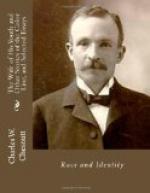Ten years make little difference in the appearance of these remote Southern towns. If a railroad is built through one of them, it infuses some enterprise; the social corpse is galvanized by the fresh blood of civilization that pulses along the farthest ramifications of our great system of commercial highways. At the period of which I write, no railroad had come to Troy. If a traveler, accustomed to the bustling life of cities, could have ridden through Troy on a summer day, he might easily have fancied himself in a deserted village. Around him he would have seen weather-beaten houses, innocent of paint, the shingled roofs in many instances covered with a rich growth of moss. Here and there he would have met a razor-backed hog lazily rooting his way along the principal thoroughfare; and more than once he would probably have had to disturb the slumbers of some yellow dog, dozing away the hours in the ardent sunshine, and reluctantly yielding up his place in the middle of the dusty road.
On Saturdays the village presented a somewhat livelier appearance, and the shade trees around the court house square and along Front Street served as hitching-posts for a goodly number of horses and mules and stunted oxen, belonging to the farmer-folk who had come in to trade at the two or three local stores.
A murder was a rare event in Branson County. Every well-informed citizen could tell the number of homicides committed in the county for fifty years back, and whether the slayer, in any given instance, had escaped, either by flight or acquittal, or had suffered the penalty of the law. So, when it became known in Troy early one Friday morning in summer, about ten years after the war, that old Captain Walker, who had served in Mexico under Scott, and had left an arm on the field of Gettysburg, had been foully murdered during the night, there was intense excitement in the village. Business was practically suspended, and the citizens gathered in little groups to discuss the murder, and speculate upon the identity of the murderer. It transpired from testimony at the coroner’s inquest, held during the morning, that a strange mulatto had been seen going in the direction of Captain Walker’s house the night before, and had been met going away from Troy early Friday morning, by a farmer on his way to town. Other circumstances seemed to connect the stranger with the crime. The sheriff organized a posse to search for him, and early in the evening, when most of the citizens of Troy were at supper, the suspected man was brought in and lodged in the county jail.
By the following morning the news of the capture had spread to the farthest limits of the county. A much larger number of people than usual came to town that Saturday,—bearded men in straw hats and blue homespun shirts, and butternut trousers of great amplitude of material and vagueness of outline; women in homespun frocks and slat-bonnets, with faces as expressionless as the dreary sandhills which gave them a meagre sustenance.




